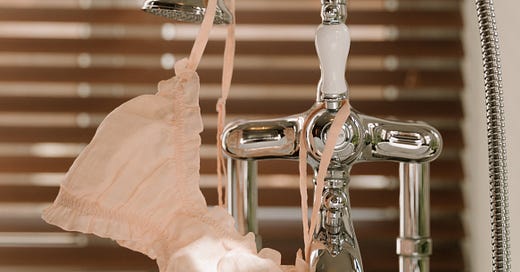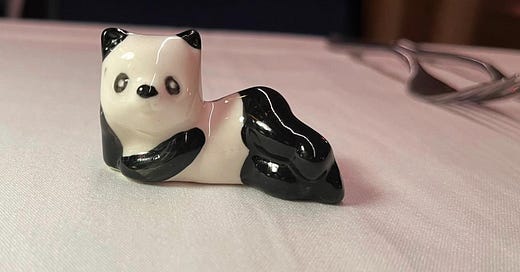

Discover more from Catalectic
F-Cups and Fluorescent Lighting
(On selling lingerie and reading Grace Paley in a post-Roe era)
In my mid-20s, I worked as a certified bra fitter for Nordstrom Lingerie. This was at Westfield Mall in downtown San Francisco, two floors up from the signature scents of Abercrombie Fierce cologne and Mrs. Fields’ cookies. I walked up a winding staircase in three-inch heels to get to work, where, in between folding matching PJ Salvage pajama sets and rearranging an easily-scattered display of Hanky Pankies, I would step into nondescript dressing rooms illuminated by the unfortunate glare of fluorescent light and wrap measuring tape around women’s ribcages, and then breasts at their fullest circumference, to calculate the distance between the two.
To the outside world, I presented as a retail associate — but, in typical Silicon Valley style, I identified as an entrepreneur. The job ostensibly served market research purposes only; I spent mornings obsessively honing my pitch for a direct-to-consumer lingerie brand with the help of overpriced coffee in the Mission. My co-founder and I had every intention of disrupting the intimate apparel industry with bras that actually fit and a measuring experience that would take place in the comfort of one’s own home.
And so, high off the gospels of lean startups and design thinking, I ventured forth into trenches lined with demi-cups and stretch lace to learn from women who knew exactly what they wanted and also what they didn’t, including one woman in her late 60s, a repeat customer who refused to let me fit her in anything but Wacoal.
(And I quote: “Darling, I’m a Wacoal whore.”)
For months in a row, I stayed hours past closing to count inventory and properly fold bra straps over fickle plastic hangers, barely making it out the door to catch the 1 California MUNI to Presidio & Clay. But the mall at night is magical — illuminated Chanel displays and carefully re-stocked piles of toys straight out of a childhood Christmas dream — and I genuinely learned a lot, e.g. men get sticker shock whenever they hand over a credit card for underwire but will pay anything to leave a lingerie department ASAP. (Yes, that delicate upper foundation will set you back $175!)
I’ll never forget the gentleman who took a bra on its hanger and held it chest-level to me, glanced at the tag on the bra, then straight at my cleavage, then back at the bra.
(And I quote: “Sorry, I didn’t mean to make this awkward. It’s just, my wife’s breasts are about the same size.”)
Of course, so much of the labor was emotional — i.e. not really about lingerie at all. I sold Spanx to a woman who couldn’t bare to show before her annual review. I delicately fastened a front-enclosure on an elderly woman while she cried about the changes hormones had wrought on her figure (and arthritis on her hands.) I fit sex workers from the local Armory and women with prosthetics post-op. I dug through the stockroom more than once in search of something — anything — to help new mothers feel like themselves. (Pro tip: Nordstrom’s alternations department can transform almost anything into a nursing bra.)
More than one woman confided in me that the era of colorful intimate apparel in her bedroom had long since passed; our conversations would turn to musings on maintaining spark and marital fidelity as we mulled over basics in black and beige.
When a mother entrusted me to fit her 12-year-old child, I found I was the one insisting on black and beige, but by no means in combination.
(Can we please stock something beside leopard print in size 32A?!)
I answered calls for help in our stockroom in the aftermath of two pink lines and processed $400 returns for impulse purchases of Chantelle DD+ Rive Gauche when, one doctor’s appointment later, full-sized breasts returned to their tear-drop shape and more comfortably fit their original C.
Around the time I went shopping for my first bra, my primary entrée into civic engagement — my single-voter-issue-if-only-I-could-vote — was abortion rights. I penned an essay on why choice matters for my eighth grade English class and ordered a bumper sticker from NARAL. Somewhere over the years, though, my attention turned to other things and I found my activist voice most consistently on issues of criminal justice reform.
Now that women’s bodily autonomy is going out of style as quickly as underwire during COVID, of course, I see the Venn Diagram of the two converging.
There’s an essay by Grace Paley — patron saint of fictional voice, political activist, poet — called “The Illegal Days,” wherein she details the experience of seeking healthcare before the passage of Roe v. Wade. Like Paley, I’m not the biggest fan of some of the messaging within the pro-choice movement (“I’ll be very truthful. I never liked the slogan ‘Abortion on demand—’,” she writes), but, in the aftermath of the loss of a right to bodily autonomy, to bicker over messaging feels all at once of primary importance and, all of a sudden, neither here nor there.
I’m thinking a lot this week about something a friend’s daughter said to me after one of my braver acts of political defiance for something unrelated. (“If you get away with it, I’m proud! But if you go to jail, I’m not.”) I think we underestimate the psychology of otherwise well-intentioned people who eventually err on the side of laws being just and reasonably made.
“These things are not talked about a lot, this kind of criminalization of the medical profession, the danger these doctors were in. It meant that they could not take care of you. It’s not even about abortion.” - Grace Paley
How long until solidarity becomes a beautiful but just-not-convenient concept, in the same way we’ve adjusted to the end of brick and mortar?
I’ve never had an abortion — I don’t have firsthand experience to shout from the rooftops in a last-ditch appeal to public empathy. I carry in my heart instead confidences of women who’ve been pregnant — and aborted, carried, or miscarried — for all the reasons you might expect and all the reasons I might have done the same. And I eventually abandoned the idea of an intimate apparel startup: tech-centric investors aren’t keen on inventory-heavy business.
Companies like True & Co and ThirdLove have make a splash in recent years by disrupting the fitting room experience, although, with hindsight, I’m no longer convinced it needed to change. Nondescript dressing rooms physically embodied by women across divides in generation and underwear preference sound to me, in 2022, like a kind of haven.
Now I’m just a girl, typing away on a keyboard, asking our government to dim the fluorescent lights.
Also Reading: “A Woman, Young and Old” in Grace Paley: The Collected Stories.
Favorite Quote: “Oh, Josephine,” she continued, her voice reaching strictly for the edge of the sound barrier, “oh, Josephine, to those loathsomes in this miserable country I’m a joke, a real ha-ha. But over there they’d know me. They would just feel me boiling out to meet them. Lousy grammar and all, in French, I swear I could write Shakespeare.”




















I like the randomness of your brain! Also how autobiographical content can be woven into a larger narrative. I admire you for these qualities of spontaneity and yet clearly well-crafted content.
Alicia, I loved this, and the way you wove the two topics together. Must read again! It seems that you could write a story based in part on your experience at Nordstrom; so many evocative elements there, not least in the emotional realm of mind-body consonance and dissonance. And, I must read more Grace Paley, wow! Thanks so much!!